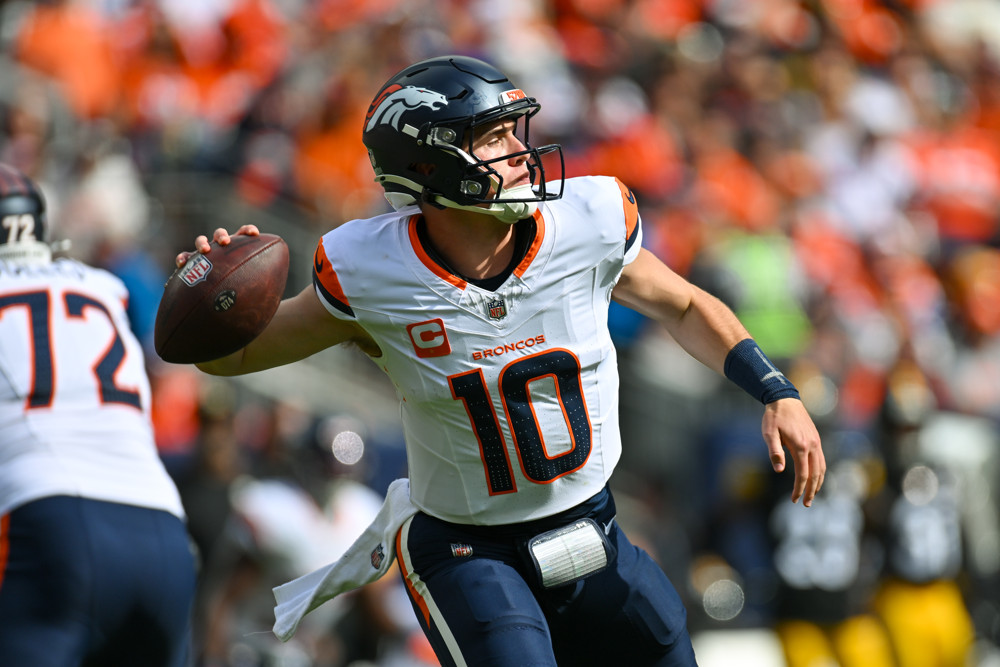
Two weeks into the Denver Broncos’ 2024 season, and so far, it feels a lot like Groundhog Day.
The defense is once again leading the way, coaching is once again making questionable calls, the quarterback situation is once again murky at best.
Despite that pain, what positives still stand out? Let’s look.
STOCK UP
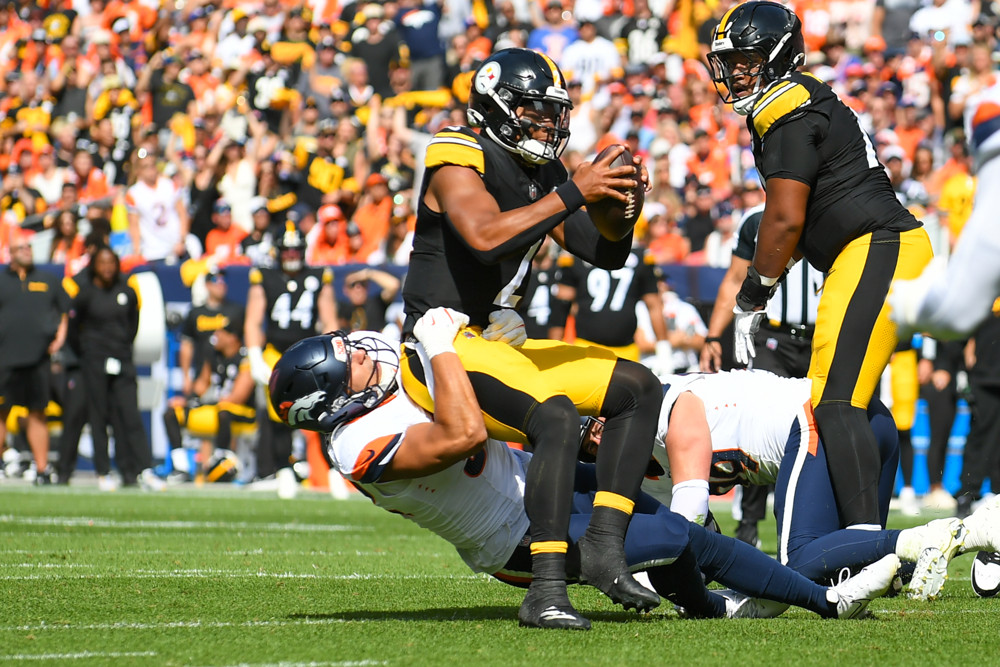
Zach Allen
First off, nearly every element of the Denver Broncos’ defense, outside their ability to defend the run in the first half, could land in the ‘Stock Up’ section here.
Against all odds, the Broncos might have a legitimately good defense this season. They currently rank 11th in Expected Points Added per Play (EPA/play) allowed, seventh in success rate, and their 2.0 points-per-drive allowed is tied with the Chiefs’ and Browns’ defenses.
Surprisingly, the leader of that unit has been Zach Allen.
Zach Allen nuking a drive by himself with a run stuff and a pressure pic.twitter.com/795xCek0wn
— Derrik Klassen (@QBKlass) September 17, 2024
Per Pro Football Focus, with 13 pressures through two games, Allen is currently tied with Chris Jones for the league lead in pressures created by an interior rusher. He also ranks third among interior linemen in Pass-Rush productivity (PRP), a stat that measures a player’s pass-rush impact per snap, and third in Pass-Rush Win Rate (PRWR).
All of Zach Allen's pressures vs the Steelers (and a bonus Jonah Elliss sack). pic.twitter.com/vwadjPmfRf
— Robby (@Robby_NFL) September 16, 2024
Through two games, Allen is legitimately playing like an All-Pro and the best member of the Broncos’ defense. That’s way above expectation, even if it doesn’t last all season. For now, he’s certainly worthy of the top ‘Stock Up’ spot.
Denver Broncos Special Teams
As we just mentioned, there’s very little to be happy about right now for Denver Broncos fans.
One thing they can be happy about is the performance of the team’s special teams.
JL Skinner and Keidron Smith have emerged as coverage aces, with a series of eye-popping tackles already, in just two games; Will Lutz is, so far, perfect on the season; Riley Dixon is punting much better than he did last year; and they’ve already pinned their opponent on the one-yard line three times.
Per FTN’s DVOA (Defense-adjusted Value Over Average) metric, arguably the best advanced analytic for measuring special teams performance, currently has the Broncos ranked as the league’s second-best special teams group. Drilling down deeper shows they rank second in punt coverage and 10th in kick return.
Riley Moss
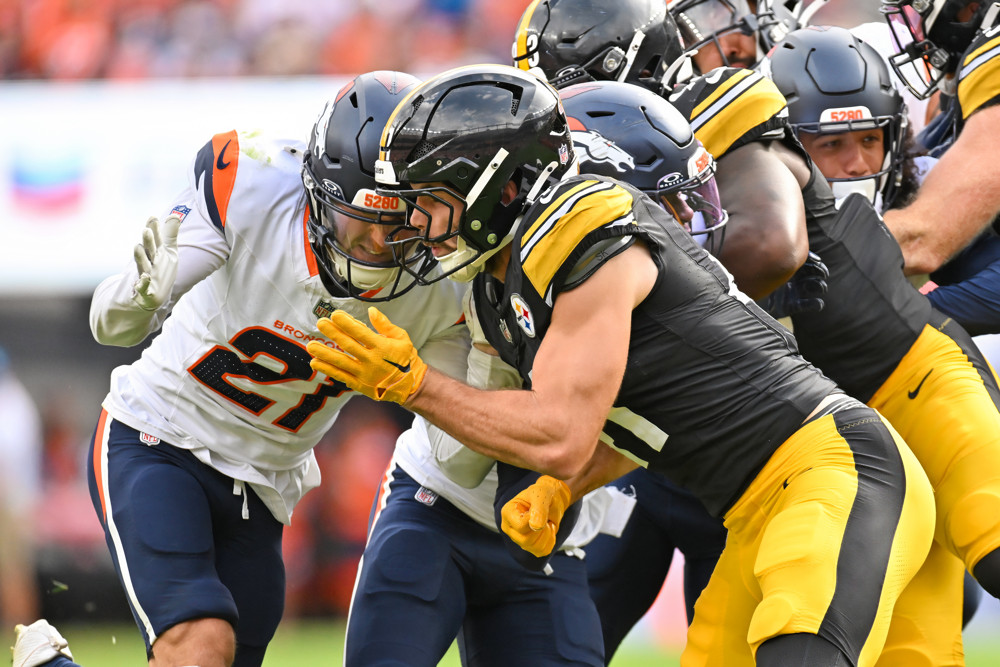
In this business, you’re bound to have some big swings and misses. Sometimes you can see them coming and sometimes you’re so confident in your misstep that you have to eat a heaping pile of crow afterwards.
This is one of the latter cases.
Through two games, Riley Moss has been a good starting cornerback. No qualifiers are necessary.
Before the season, the prayer was for serviceable cornerback play. This far exceeds that.
As the nearest coverage defender this week, Moss was targeted just four times, allowing three receptions for 17 yards. Allowing the QB to complete 75% of targets isn’t ideal, of course, but 4.25 yards per target and 5.4 yards per completion is great for a boundary cornerback.
Riley Moss vs the Steelers as nearest defender.
— Robby (@Robby_NFL) September 16, 2024
3 receptions on 4 targets for 17 yards
1.7 average yards of separation
-0.4 coverage EPA
2.3 yards of YAC per reception
+15.9% catch rate over expected.
Moss also allowed just 1.7 yards of separation, on average, and 2.3 yards after the catch. Most impressive though, is his -0.4 coverage EPA when targeted, which was dragged down considerably by a questionable pass interference call that outraged Coach Payton.
Riley Moss is shoved to the ground here and he gets a flag for pass interference… #PITvsDEN pic.twitter.com/3vEbPHWVOg
— Rate the Refs App (@Rate_the_Refs) September 15, 2024
The warts in Pat Surtain II’s much-maligned performance have been overrated, but holding up this well, even when PS2 isn’t having his best day, is another feather in Moss’s cap.
Not much is going right for Denver, but the fact they could feel like they have three quality starting cornerbacks on the roster, with two on rookie or UDFA deals, is a lovely boon. Plus, Kris Abrams-Draine still has a lot of promise behind that trio.
Bo Nix

Let’s just have a nice, level-headed discussion about the Denver Broncos’ first-round rookie quarterback.
It’s not only, ‘he’s fine and there’s nothing to worry about except his surroundings,’ or ‘he is already a bust and the Broncos need to start thinking about drafting their next quarterback.’
There’s a healthy middle ground, where most of us reside, and it’s important to keep that in mind.
The fact is, Bo Nix hasn’t been good through two games, and he hasn’t lived up to expectations.
Here is the Nix interception. This is a fairly common personnel grouping for the low red-zone. Two best big bodied possession receivers, most explosive pass catching back, their starting tight end and a fullback. Came out in 21 to get bigger and slower bodies on the field from… pic.twitter.com/6XTadfrpul
— Robby (@Robby_NFL) September 17, 2024
The footwork has regressed dramatically from training camp and the preseason, and it’s clear the speed of the game is currently a lot for him. As a result of these two factors, his accuracy also hasn’t matched the preseason sales pitch.
Nonetheless, through two weeks, he’s played two of the league’s top-seven defenses, according to EPA/play, and two of the top-six defenses, according to defensive DVOA, and he’s working with a paltry amount of surrounding talent.
He’s also a rookie, and rookies generally struggle. Stroud’s magnificent season ultimately landed the Houston Texans with the NFL’s 14th-best offensive DVOA, and that was a rousing success spearheaded by much more talent than the Broncos currently have.
Copium aside, how does Bo Nix land in the ‘Stock Up’ portion of this article?
Simply, he improved upon his debut performance by a healthy bit. Plus, although it was still, relative to the rest of the NFL, a poor starting quarterback performance, it was much closer to what we should expect from a rookie going up against a top-10 defense in his second-ever game.
Nix completed 57.1% of his passes at 7.2 yards per attempt. Those aren’t Canton-worthy numbers, but they’re real NFL numbers. In his first game, he had the sixth-worst post-merger yards-per-attempt by any quarterback.
He also completed a number of NFL-caliber throws, demonstrating he’s at least capable of it.
This is a good ass throw man. This team is just allergic to making plays. pic.twitter.com/VU9jmW3jA0
— Frankie Abbott (@FrankiesFilm) September 16, 2024
This is a good ass throw man. This team is just allergic to making plays. pic.twitter.com/VU9jmW3jA0
— Frankie Abbott (@FrankiesFilm) September 16, 2024
Looking like he belongs, even as a lesser quarterback, is a healthy leap from how lost he looked in Week 1.
If you want to look on the positive side, you could argue he’s already demonstrated much more ability for growth and development than Drew Lock. So, that’s something at least, even if there’s a long road ahead.
STOCK DOWN
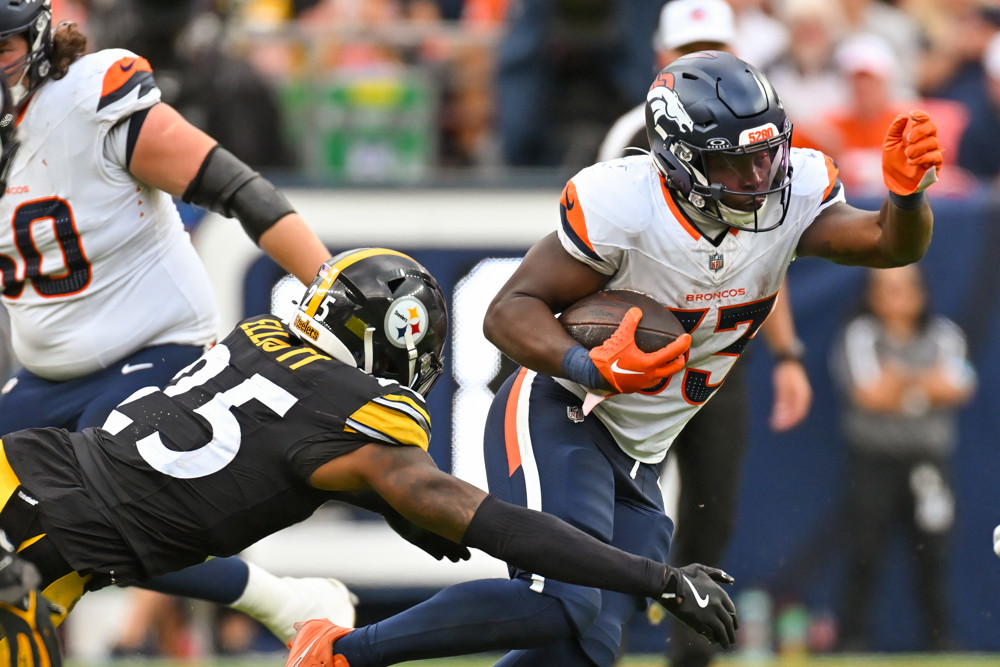
Denver Broncos Rushing Attack
Before the season, the Broncos were projected to have, at worst, a solid rushing attack that could help set the table for the first-year starting quarterback.
So far, it’s not even close to that ‘mediocre’ projection.
Through two weeks, Denver ranks 30th in rushing success rate and 25th in rushing EPA/play, with the difference there in those two metrics being largely explained by Bo Nix’s scrambles. This team comfortably has a bottom-five ground attack, in terms of designed runs, in the entire league.
That’s unacceptable when you consider that Denver has the league’s third-most expensive starting offensive line in terms of total guaranteed money.
Throughout the thread I'm going to calling what the run is, I might be wrong because sometimes inside zone and duo can look very similar, but I think I got it right for the most part.
— Josh Stecklein (@JmoneysteckNFL) September 18, 2024
First up is Duo, and I find it absolutely hilarious that Javonte doesn't bounce this run… pic.twitter.com/ak7WqhzmDy
Through two weeks, Javonte Williams has a measly 40 yards over his 19 carries, and Jaleel McLaughlin isn’t much better, with 33 yards on 13 carries. 4.0 yards per carry used to be the archaic measure of an efficient ground game, and neither of Denver’s top two backs has reached even 2.5 yards per rush so far.
Maybe Audric Estime can help once he returns from injured reserve, and Tyler Badie made the most of his single carry in Week 2, but both of those prayers seem far-fetched, as the problem doesn’t lie exclusively with the backs.
This category is labeled as a ‘Stock Down’ for the ground game because everyone involved is underperforming. The line isn’t living up to the team’s investment in them, neither is Sean Payton’s coaching, and the backfield offers much less juice than anticipated.
Here’s hoping they can find a cure soon.
Offensive Line
As a brief addendum to the discussion of the run game and the offensive line’s struggles there, the pass protection has also been ghastly.
Bo Nix has been pressured on 39 dropbacks, the second-most in the league. Meanwhile, his rate of pressured dropbacks ranks fourth, with 43.3% of his dropbacks facing some form of pressure. However, considering Nix has the league’s seventh-highest rate of quarterback-created pressure, those numbers are being inflated by the team’s rookie signal-caller.
Yet still, there are some real worries on the line.
Garett Bolles is seemingly playing through injury and now right tackle Mike McGlinchey is slated to miss the next four weeks with a MCL injury. On the interior, Ben Powers hasn’t made the leap from last year that was hoped for, Quinn Meinerz is experiencing one of the worst starts to the season of his career, and, although Luke Wattenberg has been better than expected, he remains a subpar starter.
Sean Payton
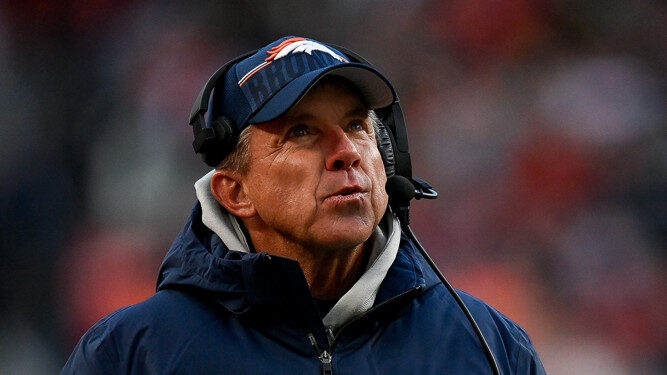
The problems are much bigger than it simply all being Sean Payton’s fault, nonetheless, he has some blood on his hands.
His fingerprints are on the aforementioned shortcomings of the ground attack, which he’s responsible for designing, and the offensive line, which represents his most serious team-building investment outside of Bo Nix, who is also raising some red flags.
That said, talent and execution are the primary problems on this team, not the scheme.
Now, that’s not to say the scheme is flawless. There is room for improvement and the staff needs to seize that void in an effort to propel growth.
The recent proliferation of Shanahan offenses and the motions often associated with them has led to the oversimplified belief that ‘motion=good’ and ‘lack of motion=bad’. However, motion for motion’s sake is not helpful, as Broncos Country experienced during the Nate Hackett and Rich Scangarello offensive eras.
Denver Broncos Pre-Snap Motion Usage in Week 2 vs Pittsburgh
— Liam Hammer (@hammerjammerjr) September 17, 2024
Passes (no motion): 33 for 183 (5.5 YPP)
Passes w/ Motion: 9 for 58 (6.4 YPP)
Run (no motion): 10 for 32 (3.2 YPP)
Runs w/ Motion: 6 for 20 (3.3 YPP)
That said, it does seem the Broncos should be leaning into utilizing more motion. Although it’s hard to draw too many conclusions from the small sample,
However, some of the gripes don’t seem to hold up under further scrutiny.
With all the conversation about Klint Kubiak's offense thought this was interesting pic.twitter.com/MzfhobnX5z
— Liam Hammer (@hammerjammerjr) September 17, 2024
The lack of play-action usage has been maligned, but, when using play-action, Nix’s completion percentage, yards per attempt, passer rating, turnover-worthy-play rate, and big-time-throw rate all decline. Now, that could just be a product of the small play-action sample, but still, it helps explain why Denver hasn’t leaned further into it.
Scheme aside, if the general primary problems with this roster are a lack of talent and a lack of execution, that ultimately falls on Sean Payton and general manager George Paton.
The execution issues plague every level of the offense, with running backs missing their lanes, receivers being painfully slow off the snap, tight ends dropping passes, offensive linemen missing blocks, and the quarterback missing reads and generally looking frazzled.
Meanwhile, the Russell Wilson trade created this team-building quagmire, but investing tens of millions in a shaky offensive line and failing to find more early contributors are team-building errs that rest on Payton, at least until the offensive front and/or Marvin Mims Jr. can right the ship.
